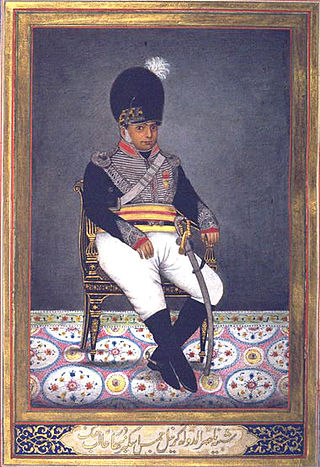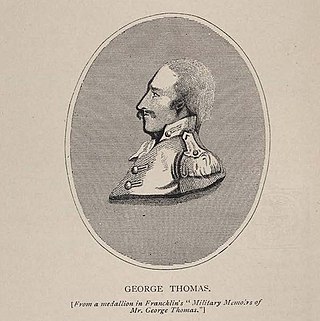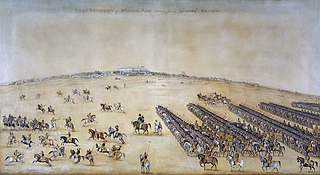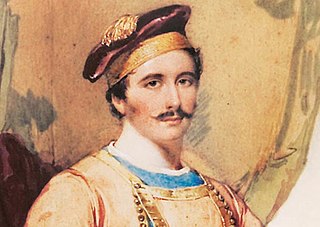
Old Delhi or Purani Dilli is an area in the Central Delhi district of Delhi, India. It was founded as a walled city named Shahjahanabad in 1648, when Shah Jahan decided to shift the Mughal capital from Agra. The construction of the city was completed in 1648, and it remained the capital of the Mughal Empire until its fall in 1857, when the British Raj took over as paramount power in India. It was once filled with mansions of nobles and members of the royal court, along with elegant mosques and gardens.

The Santa Cruz Cathedral Basilica at Fort Kochi, Kochi, is one of the nine basilicas in Kerala. Counted as one of the heritage edifices of Kerala, this church is one of the finest and most impressive churches in India and visited by tourists the whole year round. It is a place of devotion as well as a center of historic significance, endowed with architectural and artistic grandeur and colours of the gothic style.

Kashmere Gate or Kashmiri Gate is a gate located in Old Delhi in UT of Delhi, India. it is the northern gate to the historic walled city of Old Delhi. Built by the Mughal Emperor Shah Jahan, the gate is so named because it was at the start of a road that led to Kashmir.

St. Paul's Cathedral is a Church of North India (CNI) cathedral of Anglican background in Kolkata, West Bengal, India, noted for its Gothic architecture and dedicated to Paul the Apostle. It is the seat of the Diocese of Calcutta. The cornerstone was laid in 1839; the building was completed in 1847. It is said to be the largest church in Kolkata and the first Anglican cathedral in Asia. It was also the first new-built cathedral in the overseas territory of the British Empire. The edifice stands on Cathedral Road on the "island of attractions" to provide for more space for the growing population of the European community in Calcutta in the 1800s.

Colonel James Skinner was an Anglo-Indian soldier of the Maratha Empire and the Bengal Army of British India. He became known as Sikandar Sahib later in life, and is most known for two cavalry regiments he raised for the British at Hansi in 1803, known as 1st Skinner's Horse and 3rd Skinner's Horse, which are still units of the Indian Army.

George Thomas, nicknamed Jaharai Jung and Jahazi Sahib, was an Irish mercenary and later a Raja who was active in 18th-century India. From 1798 to 1801, he ruled a small kingdom in India, which he carved out of Hisar and Rohtak districts of Haryana. He is popularly known as the Raja from Tipperary.

Sir Thomas Theophilus Metcalfe, 4th Baronet, KCB was an East India Company civil servant and agent of the Governor General of India at the imperial court of the Mughal Emperor Bahadur Shah Zafar.

The 1st Horse is a regiment of the Armoured Corps of the Indian Army. It traces its origins as a cavalry regiment from the times of the East India Company, followed by its service in the British Indian Army and finally, after independence as the fourth oldest and one of the senior cavalry regiments of the Armoured Corps of the Indian Army.

Bangalore Fort began in 1537 as a mud fort. The builder was Kempe Gowda I, a vassal of the Vijaynagar Empire and the founder of Bangalore. Hyder Ali in 1761 replaced the mud fort with a stone fort and it was further improved by his son Tipu Sultan in the late 18th century. It was damaged during an Anglo-Mysore war in 1791. It still remains a good example of 18th-century military fortification. The army of the British East India Company, led by Lord Cornwallis on 21 March 1791 captured the fort in the siege of Bangalore during the Third Mysore War (1790–1792). At the time the fort was a stronghold for Tipu Sultan. Today, the fort's Delhi gate, on Krishnarajendra Road, and two bastions are the primary remains of the fort. A marble plaque commemorates the spot where the British breached fort's wall, leading to its capture. The old fort area also includes Tipu Sultan's Summer Palace, and his armoury. The fort has provided the setting for the treasure hunt in the book Riddle of the Seventh Stone.

The Canongate Kirkyard stands around Canongate Kirk on the Royal Mile in Edinburgh, Scotland. The churchyard was used for burials from the late 1680s until the mid-20th century.

The Saint John the Baptist, or John's Church, is a parish church in the diocese of Agra of Church of North India, and is located Meerut, India. The church building was built from 1819 to 1821 and is the oldest Church in North India. Near to this church lies St. John's Church cemetery. The grounds contain trees and greenery.

Cathedral Church of the Redemption, also known as the Viceroy Church, is a church in New Delhi, India, that was built between 1927 and 1931. The church is located east of Parliament House and Rashtrapati Bhavan, formerly Viceroy’s House, which was used by then British Viceroy. The Cathedral Church of the Redemption India, is a part of the Delhi diocese of the Church of North India (CNI)

Dr. B. R. Ambedkar University Delhi, formerly Bharat Ratna Dr. B. R. Ambedkar University Delhi and Ambedkar University Delhi, and simply AUD, is a state university established by the Government of the NCT of Delhi through an Act of the Delhi Legislature. The university began functioning in August 2008. It is a Unitary non-affiliating University whose main focus is on undergraduate and postgraduate studies and on research in the Humanities and the Social Sciences. It is completely funded by the State Government of the NCT of Delhi. The university is now declared eligible to receive Central Government Assistance. The university has been graded 'A' by National Assessment and Accreditation Council. It is named after the polymath B. R. Ambedkar, the architect of the Indian Constitution and one of the founding fathers of India.

Nicholson Cemetery, formerly known as the Old Delhi Military Cemetery and the Kashmere Gate Cemetery, is a Christian cemetery located in Kashmere Gate, Delhi, India. It is located near the Kashmere Gate Metro Station and west of the Inter State Bus Terminal. It is the site of the earliest known Christian burials in Delhi NCR. The cemetery was established in 1857 and is named after Brigadier-General John Nicholson, a Victorian era military officer who played a pivotal role during the Indian Rebellion of 1857. The St. James' Church, who owns the cemetery, is the oldest place of worship for the Christian community of Delhi. The church along with cemetery, St. Stephen's hostel, and the Victorian era houses of Kashmere Gate neighbourhood were once considered to be a "centripetal" part of Christians in Delhi.

William Fraser was a British India civil servant who was an Agent to the Governor General of India and Commissioner of the Delhi Territory during the reign of the last Mughal Emperor, Bahadur Shah Zafar. He was a brother of James Baillie Fraser.

Delhi Book or Delhie Book titled Reminiscences of Imperial Delhi is a collection of paintings done in Company style, commissioned by Sir Thomas Metcalfe in 1844. It contains 120 paintings by Indian artists, mainly by Mughal painter, Mazhar Ali Khan. The book was bought by the British Library in London.

The Jahaj Kothi Museum in Hisar, Haryana, India, originally an 18th-century Jain temple which was also the residence of George Thomas and James Skinner, is located inside the Firoz Shah Palace Complex which lies in front of Hisar Bus Stand.

Lothian Cemetery, is one of the oldest Christian cemeteries of Delhi located in Lothian Road that lies in Kauria Bridge bus stop, near to the General Post Office at Kashmiri Gate in Old Delhi.
The Architecture of Delhi dates back more than a thousand years. As the capital of several great empires of India, including Rajput kingdom, Delhi Sultanate, Mughal Empire, and British Raj, the city of Delhi has been a centre for art and architecture.























